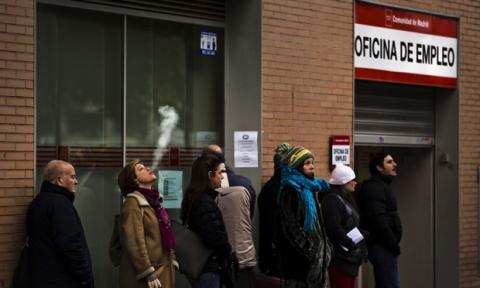The world could face years of jobless economic recovery, with young people set to be hit hardest as global unemployment continues to rise this year, a report from the International Labour Organisation warns.
As the World Economic Forum kicks off in the Swiss town of Davos on Wednesday with a focus on growing inequality, the ILO has highlighted a "potentially dangerous gap between profits and people".
The UN agency forecasts millions more people will join the ranks of the unemployed as companies choose to increase payouts to shareholders rather than invest their burgeoning profits in new workers.
The ILO's Global Employment Trends report forecasts that world unemployment will rise to 6.1% this year from 6% in 2013 and will remain well above its pre-crisis rate of 5.5% for several years.
GRAPH: The Unemployment Rate: Developed Countries versus the World
It puts the youth unemployment rate at 13.1%, more than double that for the whole workforce and almost three times the adult rate of 4.6% – a record for the ratio of youth to adult unemployment.
Guy Ryder, the ILO's director-general also highlighted rising inequality as wages fail to pick up, long-term unemployment problems intensify and progress stalls on cutting working poverty.
"Corporate profits are up and global equity markets are looking forward to another year of plenty, while at the same time unemployment and household incomes stand still," he said.
"The modest economic recovery has not translated into an improvement in the labour market in most countries. Businesses have been sitting on cash or buying back their own stocks, rather than investing in productive capacity and job creation."
His comments follow a report by Oxfam that the world's richest 85 people control as much wealth as the poorest half of the global population put together.
Released on the eve of the Davos meeting of political and business big-hitters, the charity's report found the world's richest 85 share a combined wealth of £1tn, as much as the poorest 3.5 billion.
Ryder warned of the economic and social consequences of rising inequality, with labour market problems expected to worsen this year.
"If we fail to act, if we fail to tackle the youth jobs crisis, long-term unemployment, high drop-out rates and other pressing labour market issues, we will be destroying hopes for sustainable growth – and sowing the seeds of further, and perhaps deeper social unrest," he said.
The ILO said 5 million more people became unemployed last year, taking the global total to 202 million. That is forecast to rise to 215 million jobseekers by 2018 as employment growth, at 40 million net new jobs a year, fails to keep pace with the 42.6 million people expected to enter the labour market every year.
Young people will continue to be particularly affected by what the ILO describes as a "weak and uneven recovery".
The proportion of young people not in employment, education or training (NEETs) continues to rise. Some of the worst rates are in those countries hit by the eurozone crisis. In Spain and Ireland more than one in five young people are NEETs.
The ILO also painted a gloomy outlook for the long-term unemployed. "The average length of spells of unemployment has increased considerably, a further sign of feeble job creation," the report said.
"In many advanced economies, the duration of unemployment has doubled in comparison with the pre-crisis situation."
The average duration of unemployment has hit nine months in Greece and eight months in Spain.
The findings on so-called working poverty are mixed. The ILO said the number of working poor continues to decline globally, albeit at a slower rate than in previous decades.
In 2013, an estimated 375 million workers – or 11.9% of the world's workforce– lived on less than $1.25 (76p) a day, while 839 million – 26.7% – had to cope with $2 a day or less. That compares with much higher numbers in the early 2000s, of 600 million and more than 1.1 billion, respectively.
The ILO said emerging economies would continue to enjoy the lowest combined unemployment rate this year. It forecasts a jobless rate of 5.1% for the emerging economy members of the G20 group of nations, compared with 8.4% for the advanced economy members.
But it notes that growth in emerging markets has slowed markedly in the past two years.
That was underscored by official data from China showing the joint-weakest growth rate since 1999. GDP was up by 7.7% in the final three months of 2013, slightly down on the 7.8% growth seen in the third quarter.
In the previous decade, China grew at 10.5% annually, but growth in 2012 and 2013 was 7.7%.
The ILO said China's rapid growth had been reflected in a stark change in its workforce, as agricultural workers moved to take jobs in the fast expanding manufacturing sector. The share of the workforce employed in agriculture nearly halved, from around 70% at the beginning of the 1980s to 35% more recently.
But now China needs to press ahead with moves to improve productivity, as the supply of workers will not grow boundlessly, the ILO warned.
"The absolute number of people aged 15–64 in China is expected to decline in the years to come. As a consequence, China's potential pool of workers for the manufacturing sector is not growing any more," the report said.


Spread the word